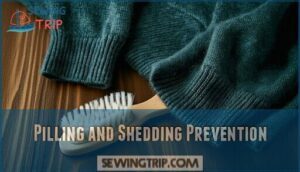This site is supported by our readers. We may earn a commission, at no cost to you, if you purchase through links.

Its natural fibers are designed to regulate body temperature by trapping air, which keeps you warm in winter and cool in summer.
Cashmere is also hygroscopic, meaning it absorbs moisture from your skin and releases it into the air, helping you stay dry and comfortable.
Unlike synthetic fabrics, it allows air to circulate, preventing that sticky or overheated feeling.
It’s lightweight yet insulating, making it ideal for layering. If you’ve ever wondered why cashmere feels so luxurious, its breathability plays a big role—there’s more to explore!
Table Of Contents
- Key Takeaways
- Cashmere Breathability Explained
- Is Cashmere Breathable
- Cashmere Fabric Properties
- Benefits of Cashmere Breathability
- Cashmere Vs Other Fabrics
- How Cashmere Regulates Body Temperature
- Cashmere Care and Maintenance
- Cashmere Blends for Enhanced Breathability
- Year-Round Cashmere Wear
- Cashmere Durability and Longevity
- Frequently Asked Questions (FAQs)
- Conclusion
Key Takeaways
- You’ll enjoy excellent temperature regulation with cashmere as its natural fibers trap air to keep you warm in winter while allowing heat to escape in summer, adapting to your body’s needs.
- You’ll stay dry and comfortable as cashmere wicks moisture away from your skin through its hygroscopic properties, preventing clamminess and reducing odor.
- You’ll find cashmere more breathable than regular wool, with finer fibers that create a lightweight fabric that insulates without bulk or overheating.
- You’ll get year-round versatility from cashmere, making it perfect for layering in any season due to its unique ability to provide warmth without compromising breathability.
Cashmere Breathability Explained
You might be surprised to learn that cashmere isn’t just about softness—it’s highly breathable too.
Cashmere isn’t just luxurious—its breathability keeps you effortlessly comfortable, adapting to your body in every climate.
Its natural fibers regulate temperature and wick away moisture, keeping you comfortable in almost any climate, with highly breathable properties.
Natural Fibers and Temperature Regulation
Breathable cashmere, made from the fine goat undercoat, guarantees excellent temperature regulation due to its natural fibers.
Its fiber hygroscopy adjusts to your body’s needs, offering comfort factors in any season.
Here’s how cashmere provides natural ventilation:
- Adapts to seasonal changes
- Insulates without trapping heat
- Wicks moisture effectively
- Promotes airflow across fibers
- Maintains consistent cashmere temperature to ensure you stay comfortable, thanks to its ability to provide natural ventilation.
Moisture Wicking Properties
Cashmere’s fiber structure excels at moisture wicking, pulling sweat away from your skin for quick drying and improved comfort.
Effortlessly wicks moisture away, keeping you dry and comfortable with cashmere’s unrivaled softness and year-round breathable luxury.
This natural process supports odor control and guarantees skin comfort, even in warm conditions.
Cashmere breathability works together with moisture absorption to regulate temperature effectively. It keeps you dry and comfortable, making it an excellent choice for year-round wear.
Hygroscopic Qualities
Surprisingly, cashmere’s hygroscopic nature works wonders for maintaining comfort.
Its fiber structure absorbs moisture from your skin microclimate, balancing temperature and enhancing breathability.
This moisture-wicking ability keeps you dry yet cozy, promoting comfort enhancement across seasons.
To improve comfort during physical activities, consider other moisture-wicking fabric options.
Thanks to these unique cashmere properties, it naturally supports temperature balance, making it a reliable choice for year-round wear while ensuring ideal breathability and moisture absorption.
Is Cashmere Breathable
You might wonder: is cashmere breathable? Absolutely! Its fine natural fibers allow air to circulate, making cashmere a standout among breathable fabrics.
It wicks away moisture, keeping you dry and comfortable, even in hot weather. This breathability is why summer cashmere is gaining popularity, offering unparalleled Cashmere Comfort without overheating.
Plus, its odor resistance adds to its appeal for year-round wear. One reason for this is that cashmere, like wool, boasts superior moisture management, keeping the skin dry.
Whether layering during cooler nights or embracing its Climate Versatility, cashmere balances warmth and airflow effortlessly, making it both luxurious and practical.
Cashmere Fabric Properties
Cashmere’s fabric properties make it exceptionally soft, lightweight, and breathable, offering unmatched comfort. Its natural fibers provide warmth without bulk, promoting air circulation while keeping you cozy year-round.
Softness and Lightweight
Thanks to its delicate fibers, cashmere offers a unique combination of softness and lightweight comfort.
The gentle feel of cashmere touch is perfect for sensitive skin, while its weightless warmth provides incredible versatility.
You’ll love its airy comfort, allowing cashmere benefits like breathability to shine year-round.
Its soft texture enhances your overall experience without feeling heavy or restrictive.
Insulation and Warmth
In the context of Lightweight Insulation and Winter Comfort, cashmere breathability stands out. Its fine fibers provide unparalleled warmth without added bulk, making it perfect for cold weather.
Wondering, is cashmere warm? Absolutely! Cashmere benefits include:
- Eight times warmer than typical wool.
- Thin yet effective insulation for freezing days.
- Gentle Temperature Regulation year-round.
- Provides Breathable Layers against chills.
- Incredible softness for comfort.
These characteristics make cashmere a valuable choice for those seeking warmth without the bulk, highlighting its unique properties in the realm of winter clothing and accessories.
Air Circulation and Ventilation
Cashmere breathability stems from its fiber structure and unique weave density, allowing excellent air permeability.
Tiny air pockets within the fabric enhance convection cooling, maintaining your body microclimate.
These textile properties provide light insulation while wicking moisture effectively, ensuring cashmere feels airy and breathable, without overheating or trapping excess heat against your skin.
Benefits of Cashmere Breathability
Cashmere’s breathability helps reduce sweating by wicking moisture away, keeping your skin dry and odor-free.
Its lightweight, soft texture also enhances comfort, making it perfect for relaxing or for those with sensitive skin.
Reduced Sweating and Odor
Cashmere’s breathability and moisture-wicking properties reduce sweating, keeping you dry.
It naturally resists odor by limiting bacteria growth, even during temperature shifts.
This guarantees skin comfort and enhances relaxation, whether it’s a hot summer day or a chilly winter evening.
With excellent moisture control, it balances body temperature, offering unmatched climate versatility and extended freshness throughout the day, providing skin comfort.
Improved Comfort and Relaxation
With its softness and breathable comfort, cashmere offers a sensory experience that promotes natural relaxation.
Its lightweight feel reduces stress and enhances therapeutic benefits by adapting to your body’s needs.
The breathability helps you stay cool and dry, boosting sleep quality and overall cashmere comfort.
Authentic cashmere fibers become softer over time.
Ideal for unwinding, it’s like a gentle hug for your skin, providing natural relaxation.
Suitable for Sensitive Skin
If you’re prone to skin irritation, cashmere benefits sensitive skin with its hypoallergenic qualities and unmatched fiber smoothness.
Its breathability prevents sweating, keeping you dry and comfortable.
Cashmere’s skinfriendly texture, free of harsh fibers, reduces itchiness, and it’s a luxurious choice.
Stick to gentle detergents while washing to maintain softness and irritation prevention.
It’s a skin-comforting choice you’ll appreciate year-round.
Cashmere Vs Other Fabrics
When comparing cashmere with other fabrics, you’ll notice significant differences in breathability, softness, and warmth.
Cashmere stands out for its ability to regulate temperature better than wool, merino, or alpaca, while still being lighter and more comfortable to wear.
Comparison With Wool and Synthetic Fabrics
When comparing fabrics, cashmere outperforms wool and synthetic options in softness, breathability, and moisture-wicking.
Wool provides more durability but lacks cashmere’s lightweight comfort. Synthetic fabrics trap moisture, compromising comfort, while cashmere remains temperature-regulating and odor-resistant.
Here’s a quick fiber comparison:
| Feature | Cashmere Comfort | Wool Warmth | Synthetic Moisture |
|---|---|---|---|
| Softness | Silky Smooth | Slightly Itchy | Varies |
| Breathability | Excellent | Good | Limited |
| Moisture Managing | Superior | Moderate | Poor |
| Durability | Medium | High | High |
Merino Wool and Cashmere Breathability
Merino wool and cashmere each have unique breathability.
Cashmere advantages include its finer fiber diameter, offering unmatched softness and luxurious comfort.
However, merino wool excels in moisture-wicking, making it a better option for active use.
Here’s a quick comparison:
The key differences between merino wool and cashmere lie in their temperature control and durability, with merino wool offering balanced year-round performance and being more durable.
Alpaca Wool and Cashmere Comparison
Alpaca wool and cashmere are both soft and breathable, but they differ in key ways.
Alpaca wool offers a warmth factor and durability edge due to its hollow fibers, while cashmere wins on softness and weight analysis.
Alpaca’s natural hypoallergenic properties and breathability make it practical, though cashmere still feels luxurious for skin contact.
| Feature | Cashmere | Alpaca Wool |
|---|---|---|
| Softness | Softer, delicate | Slightly coarser |
| Warmth Factor | Warm, lightweight | Superior insulation |
| Durability | Less durable | Long-lasting |
| Breathability | Highly breathable | Excellent ventilation |
How Cashmere Regulates Body Temperature
Cashmere keeps you cool in summer by wicking away moisture and warm in winter by trapping heat through its insulating fibers.
This unique adaptability helps regulate your body temperature, preventing overheating and ensuring year-round comfort.
Cooling in Summer and Warming in Winter
Seasonal cashmere offers unmatched temperature regulation, making it the best breathable fabric for year-round versatility.
In summer, cashmere wicks away moisture, keeping you cool and dry with breathable comfort.
Winter cashmere, on the other hand, provides exceptional thermal regulation, insulating warmth without bulk, and its unique fibers adapt effortlessly to climate changes, ensuring moisture-wicking and comfort whether it’s hot or cold, making it ideal for year-round versatility.
Adaptive Insulation and Breathability
Cashmere’s fiber structure offers adaptive insulation and breathability, making it perfect for climate adaptability and year-round comfort.
Its thermal regulation works seamlessly, adjusting to temperature shifts.
You’ll enjoy these benefits:
- Heat in winter: Insulates to keep you warm.
- Cool in summer: Wicks moisture to stay breathable.
- Seasonal versatility: Adds lightweight layering benefits.
- Day-to-night ease: Maintains thermal comfort effortlessly.
Preventing Overheating and Discomfort
Thanks to its breathability and moisture management, cashmere regulates body temperature effectively, preventing overheating and enhancing skin comfort.
Its natural fibers allow for airflow importance, making it adaptable to any climate.
Use layering strategies with lightweight, breathable options in warmer seasons, this sweat reduction feature keeps you cool and dry, ensuring comfort maximization throughout the year with cashmere’s unmatched softness.
Cashmere Care and Maintenance
Taking care of cashmere properly guarantees its softness, durability, and timeless appeal.
By following simple steps like gentle washing, correct storage, and preventing pilling, you can keep your cashmere looking and feeling luxurious for years.
Washing and Drying Techniques
Gentle washing preserves cashmere. Hand wash or use a delicate washing cycle with cold water.
Opt for cashmere-specific detergents for fabric care, avoiding regular ones. Using the right detergent is vital for cashmere.
Gently press water out—don’t wring. Lay flat on a clean towel for drying; reshaping it, called blocking, maintains form.
Skip dryers and hangers. Quick stain removal guarantees lasting quality and softness.
Storage and Handling Tips
After washing, proper cashmere care guarantees longevity.
Always clean garments before storage to prevent odors or stains. Fold, don’t hang, to maintain shape and avoid stretching.
Use breathable storage containers with cedar blocks for moth prevention. Consider using specialized cashmere containers to keep your items in top condition.
Control humidity levels to protect fibers from damage. Regularly check items to keep your clothing maintenance routine effective and stress-free.
Pilling and Shedding Prevention
Avoid pilling and shedding by handling cashmere with care.
Use gentle brushing to remove loose fibers and store properly to maintain its durability.
Stick to soft washing techniques and never rub forcefully.
Always avoid friction with rough surfaces or fabrics to protect fiber quality.
Check the table below for essential tips:
| Tip | Why It Helps | Tools Needed | Frequency |
|---|---|---|---|
| Gentle Brushing | Prevents shedding | Soft bristle brush | Occasionally |
| Washing Techniques | Reduces wear on fibers | Mild detergent, cold water | When needed |
| Proper Storage | Preserves cashmere quality | Breathable cotton bags | Always |
| Avoid Friction | Limits pilling and damage | Gentle handling | Daily care |
Cashmere Blends for Enhanced Breathability
When you combine cashmere with materials like silk or cotton, you get lighter, more breathable fabrics that retain cashmere’s signature softness.
These blends improve airflow, wick away moisture, and are perfect for staying cool in warm or humid climates.
Silk and Cotton Blends
Silk and cotton blends enhance cashmere’s breathability by combining silk’s smooth texture with cotton’s lightweight comfort.
These cashmere blends offer breathable luxury while keeping moisture-wicking properties intact. Silk blends add elegance, while cotton blends provide a cost comparison advantage.
Weave variations improve airflow, making them ideal for warmer conditions. Though softer, these blends require mindful care to maintain enhanced comfort, which is a key aspect of their breathable luxury.
Improved Airflow and Moisture Wicking
Cashmere blends, like those with silk or cotton, improve airflow and moisture-wicking abilities.
The fiber structure and lower weave density increase air permeability, allowing sweat evaporation and greater breathability.
This enhances your comfort level, providing breathable luxury without compromising softness.
Ideal for staying dry, these blends balance moisture control with the timeless elegance of cashmere for all-day freshness.
Suitable for Warm and Humid Climates
Cashmere shines in humid climates, thanks to its natural breathability and lightweight fibers.
Its moisture-wicking properties keep you dry while offering superior comfort, even in hot, sticky weather.
Summer cashmere benefits include versatile styles like shawls or fine-gauge sweaters, perfect for layering without overheating.
Cashmere’s temperature-regulating nature stems from the cashmere goat’s undercoat.
By regulating temperature, cashmere effortlessly combines softness with practicality, making it ideal for both summer and warm climates.
Year-Round Cashmere Wear
You can wear cashmere in any season because its breathable fibers regulate body temperature, keeping you cool in summer and warm in winter.
This versatility makes it ideal for layering, seasonal weather, and stylish, functional outfits year-round, due to its ability to provide breathable comfort.
Layering and Versatility
Cashmere brings versatility to layering with its breathable, lightweight nature, making it perfect for seasonal shifts.
Pair a cashmere sweater over a dress for stylish comfort or drape a scarf for effortless warmth.
Its climate adaptability guarantees cashmere works as a wardrobe essential for travel outfits and daily styling options, offering both functionality and elegance throughout the year.
Transitional Seasons and Climate Adaptation
Seasonal layering with cashmere guarantees climate comfort during cooler mornings and warmer afternoons.
Its adaptable styles make it perfect for seasonal shifts, offering breathable luxury that adjusts effortlessly to changing conditions.
Lightweight cashmere layering pieces fit any travel wardrobe, balancing insulation and ventilation.
Year-round cashmere effortlessly supports climate adaptability, keeping you warm or cool without bulk or discomfort.
Stylish and Functional Cashmere Garments
The beauty of cashmere lies in its ability to balance comfort and style across seasons.
Opt for seasonal cashmere designs like breathable, lightweight summer shawls or chic layering pieces for cool evenings.
Cashmere accessories, such as scarves, elevate occasion dressing effortlessly. Explore options for cashmere summer wraps for lightweight elegance.
Ethical cashmere garments also enhance your wardrobe and guarantee you’re investing in durable, versatile fashion that’s always in season, while simultaneously providing a sustainable choice.
Cashmere Durability and Longevity
When cared for properly, cashmere offers impressive durability, maintaining its softness and shape for years. Its natural breathability and moisture-wicking properties help prevent shrinkage and wrinkling, ensuring your investment lasts.
Breathability and Moisture Management
Cashmere’s breathability and moisture-wicking abilities make it a standout fabric.
Its hygroscopic nature absorbs moisture, keeping you dry and comfortable.
Whether enjoying lightweight comfort on a warm day or its sweat-reducing benefits during active wear, this breathable luxury excels.
Plus, odor resistance guarantees freshness, even in summer cashmere.
It’s a great way to stay cool and stylish effortlessly.
Preventing Shrinkage and Wrinkling
To prevent shrinkage, always wash cashmere in cool water using a mild detergent; avoid harsh rubbing.
Gently press out excess moisture with a towel and lay flat to dry.
For wrinkles, skip ironing—steam instead.
Proper storage solutions, like breathable bags, preserve fiber composition.
Following care instructions keeps cashmere soft, moisture-resistant, and in excellent shape over time.
Extending Cashmere Lifespan and Quality
To guarantee your cashmere retains its lifespan and durability, follow key care instructions.
Use proper storage with airtight containers for moth protection. Stick to gentle washing techniques and avoid harsh detergents.
Pilling prevention is simple—use a fabric comb. For stubborn stains, opt for professional cleaning.
With mindful cashmere care, you’ll protect its softness and quality for years. To prevent shrinkage, it’s also vital to understand proper washing techniques.
Frequently Asked Questions (FAQs)
Is cashmere more breathable than wool?
Cashmere practically breathes like it has lungs, outperforming regular wool.
Its ultra-fine fibers wick away moisture and let air flow freely, keeping you cool in heat and warm in cold without the bulk of traditional wool, making it a superior choice due to its ability to breathe.
What are the cons of cashmere?
Cashmere is expensive, delicate, and prone to pilling.
It requires special care, like hand washing and avoiding heat.
It can shrink easily, and lower-quality versions may irritate sensitive skin or lack long-lasting durability.
Will I sweat in cashmere?
Imagine this: you’re wrapped in a cozy cloud that breathes better than you do after climbing stairs.
Cashmere’s breathability wicks away moisture, keeping you cool and dry, so sweating in it’s unlikely.
Is cashmere hypoallergenic?
Generally, cashmere is hypoallergenic for most people.
You’ll find it’s gentle on sensitive skin due to its natural fibers, which don’t contain common allergens.
However, some might react to lanolin traces in unwashed cashmere.
How often should cashmere be washed?
You’ll only need to wash your cashmere every 5-7 wears or once per season.
Too frequent washing can damage fibers, while spot cleaning between washes works for minor stains.
Don’t wait until it’s visibly dirty.
What is the best way to store cashmere?
Store your cashmere folded in breathable cotton bags or acid-free tissue paper.
Avoid hanging to prevent stretching.
Keep in cool, dry places away from direct sunlight and moths.
Add cedar blocks for natural protection.
Does cashmere stretch?
Yes, cashmere stretches with wear but returns to shape with proper care.
You’ll notice gentle stretching during use, but it won’t lose its form permanently unless exposed to improper washing or hanging techniques.
What is the average annual cashmere yield per goat?
By jove, you’ll get about 4 ounces (100-150 grams) of cashmere per goat annually. That’s why it’s precious – you’d need 4-6 goats’ yearly yield to create just one sweater.
How does cashmere fare in tropical climates?
Cashmere works surprisingly well in tropical climates. Its breathable fibers wick moisture away from your skin while regulating temperature. You’ll find lightweight cashmere pieces comfortable year-round, especially in air-conditioned environments.
Can cashmere maintain comfort in high humidity levels?
Thanks to its hygroscopic properties, you’ll stay comfortable in humid conditions as cashmere efficiently wicks moisture away from your skin.
It won’t feel clammy against your body like synthetic fabrics often do.
Conclusion
Like a chameleon adapting to its surroundings, cashmere truly shines in its breathability across all seasons.
Yes, cashmere is breathable—making it worth the investment for year-round comfort.
Its unique fiber structure wicks moisture, regulates temperature, and allows air circulation while feeling luxuriously soft against your skin.
Whether you’re layering in winter or wearing a light sweater in spring, cashmere’s natural properties keep you comfortable without overheating.
Your body will thank you for choosing this versatile, breathable luxury.
- https://www.orvis.com/womens-cashmere-sweaters
- https://blakemill.co.uk/blogs/styling/warmth-in-winter-cool-in-summer-the-dual-climate-comfort-of-cashmere?srsltid=AfmBOooIy4ftjJHbyO41ugaU3egtksa6LpMOSlOwuElaAYnySjzmHaPW
- https://www.signaturecashmere.com/blogs/news/is-cashmere-too-hot-for-summer-signature-cashmere?srsltid=AfmBOoprV1CYKlkATTsg1hNVv9TzIOgl_ZqfpulngHE3COrPnEeoLXxw
- https://us.npeal.com/blogs/stories/why-cashmere-is-perfect-for-summer
- https://beachwoodbaby.com/blogs/news/how-to-wear-cashmere-in-the-summer-without-overheating?srsltid=AfmBOorMkr64NuPN1ofdxwdq9DAnQRiEECvqiVs335nddWV3GmL9lvJC



















